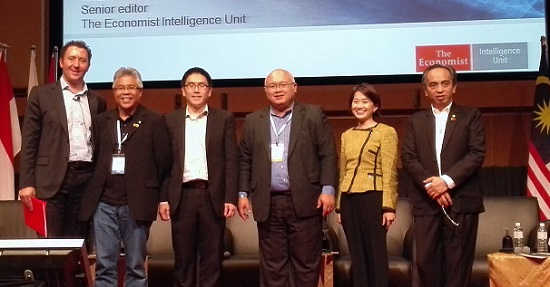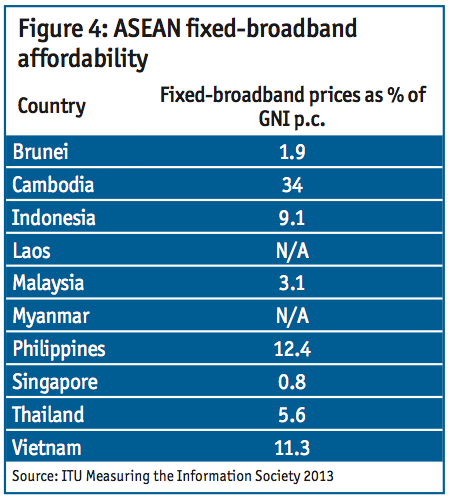Broadband in Asean: Malaysia not that bad actually
By Gabey Goh September 30, 2014
- Most Asean countries have strong broadband plans, but room for improvement
- Malaysia and Singapore ahead of the curve, former faces more challenges though

MALAYSIAN Communications and Multimedia Commission (MCMC) chairman Mohamed Sharil Tarmizi had more than one person chuckling when he asked: “Before I speak, [are there] any mobile players in the room?”
The 'room' in question was the banquet hall of the Kuala Lumpur Convention Centre on the last day of KL Converge, a three-day event organised by the Ministry of Communication and Multimedia and MCMC as a platform for users, developers, producers, writers, directors and animators to come together to meet and share ideas.
Sharil was participating in a roundtable discussion centred on a report commissioned by Huawei and conducted by the Economist Intelligence Unit (EIU).
Titled The Future of Broadband in South-East Asia, the report examined broadband implementation policies and the remaining challenges to adoption in South-East Asia.
A few scattered hands sheepishly popped up in the room in response to Sharil’s question, prompting him to remark: “See? They will tail me everywhere, waiting for any nugget of information.”
Such new information wasn't forthcoming from Sharil, a seasoned player in navigating the political sensitivities between industry and public sector in his role as the head of the country’s regulator of the communications and multimedia industry.
Especially on the one topic that is currently the focus of intense obsession by the entire telecommunications industry – the Malaysian Government’s spectrum refarming exercise that is expected to happen in 2015.
Sharil was on that stage to talk about Malaysia’s approach to planning, executing and enabling digital inclusion via affordable access to broadband Internet.
He was joined by Yahkup Menudin, chief executive officer (CEO) of the Authority for Info-communications Technology Industry of Brunei (AITI); Foo Fang Yong, head of Huawei Malaysia’s Carrier Business Group; Jacqueline Poh, managing director of the Infocomm Development Authority (IDA) of Singapore; and Louis Casambre, Undersecretary of the Philippines’ Department of Science and Technology (DOST). The roundtable discussion was moderated by Charles Ross, a senior editor with EIU.
Room for improvement

It was clear from the start that when it came to a cohesive and in-motion national policy for broadband access, Singapore and Malaysia were ahead of the curve.
The report’s findings portrayed a majority of Asean countries as having strong broadband plans in place, although all apart from Singapore (which ranks second globally) were seen as in need of further development when compared against networked readiness globally.
Huawei’s Yong noted that today, the marketplace already has technologies that will make higher reach and speeds possible.
“It is exciting to see the region strengthen its policies and investments to leverage the full potential of these technologies. This will most definitely have a positive impact on Asean economics and underpins Huawei’s commitment to the region,” he added.
One finding of the report, which would probably spark an initial knee-jerk reaction of denial by many Malaysians, is the fact that the country is identified as the only developing country in Asean that has 'affordable broadband,' according to the parameters defined by the Broadband Commission.
The Broadband Commission defines affordable broadband as less than 5% of average monthly income. By this measure, only Singapore, Brunei, and Malaysia meet this global criterion in Asean (see table below).

Of course, it still can’t compare with Malaysia’s southern neighbour and the fact that consumers – should they need to – can get a 1Gbps broadband plan for only S$49.99 (US$ 39.45)
“Don’t ask me when Malaysia will get 1Gbps for less than S$50,” Sharil teasingly admonished the crowd following IDA’s Poh outlining Singapore’s own strategy and approach to broadband access.
 Poh (pic) admitted that Singapore benefits "geographically" because the island-nation is densely populated with many 'high rises.'
Poh (pic) admitted that Singapore benefits "geographically" because the island-nation is densely populated with many 'high rises.'
“It was easier for us to go with a wired broadband strategy for national coverage, although there was some pressure for us to go with cellular technology to accomplish this, over trenching to lay down the cables.
“At first we weren’t sure if it was worth spending money on such infrastructure as the demand was uncertain at the time, but as it turns out the saying for buying hard drives ‘once you have it, you fill it up’ certainly applied,” she added.
Poh shared that Singapore reached its universal service obligation last year, with 105% of residential households having access to Internet, 46% of which are connected via fibre to the home (FTTH).
Sharil was understandably exasperated, the natural result of the sheer number of queries he must have gotten ever since that 1Gbps plan became available in Singapore at the start of the year.
“Singapore always puts us under pressure with what they’ve done. However, Malaysia is a different animal altogether and our approach is to try and get everyone connected first.
“That was the focus of the National Broadband Initiative in 2010, the draft of which began in 2008 – to get people connected by whatever means necessary be it via wired or wireless technology – we went with a technology-agnostic approach,” he added.
Under the 10th Malaysia Plan, the Government has set a target to increase the broadband penetration rate to 75% of households by 2015.
Digital divide
The urban-rural divide in terms of connectivity was also another major challenge identified by the report.
In Malaysia, there is a significant gap in broadband and mobile phone penetration rates between Kuala Lumpur, which has almost twice the number of online users, and rural areas.
About 40% of the population lives in rural areas, providing a challenge for the rollout of fixed-line broadband infrastructure. The same essentially holds true for mobile phone penetration (see table below).

Interestingly enough, the report found that Putrajaya (87%), the administrative capital of the country, has a lower mobile penetration rate than Sabah (87.6%).
Despite its initial success, Malaysia has some ways to go, in particular in comparison with the speed and near-universal coverage achieved by Singapore.
“Broadband development continues to be a work in progress,” Sharil said.
And while work continues on getting the entire nation connected, speaking to reporters after the event, Sharil shared that what keeps him motivated is the fact that lives are being impacted in a positive way via access to the Internet.
He highlighted two awards categories being given out by MCMC during KL Converge – the Agent for National Transformation Award 2014 (ANT 2014) and Broadband Empowered Entrepreneur Award ( BEE Award 2014).
The ANT was created to honour outstanding and successful individuals or groups who have created the biggest impact and have made exceptional contributions to their target communities by utilising broadband connectivity in managing their respective operations and activities.
BEE recognises the outstanding achievements of entrepreneurs who managed to develop and transform their conventional businesses that previously only exists ‘offline,’ to the online world. The eight BEE award winners were involved in a wide range of businesses from seaweed and accessories to traditional kuih (cakes/ desserts).
“People are always focused on the negative especially when it comes to social media, but I’d rather focus on the good. The positive ways people are using the Internet to better their lives and the lives of others, that’s really what gets me up in the morning,” Sharil said.
To read The Future of Broadband in South-East Asia report [PDF document] in full, click here.
Related Stories:
Huawei and Maju Nusa deploy mobile network sharing system in rural Malaysia
Broadband plays critical role in sustainable development: Report
The economic impact of broadband?
Brunei, Indonesia, Malaysia and Singapore to align with 700 MHz plan
For more technology news and the latest updates, follow us on Twitter, LinkedIn or Like us on Facebook.


